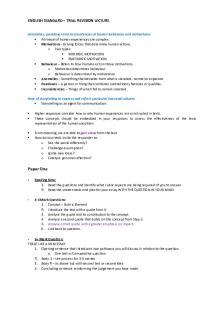UNIT1. Standard English in the world PDF

| Title | UNIT1. Standard English in the world |
|---|---|
| Author | Luísa Aldao |
| Course | Variaciones Fonético-Fonológicas de la Lengua Inglesa |
| Institution | UNED |
| Pages | 4 |
| File Size | 121.5 KB |
| File Type | |
| Total Downloads | 78 |
| Total Views | 118 |
Summary
Resumen del manual escrito por Trudgill & Hannah: Standard English Varieties; The Spread of English Overseas; The Nature of Overseas English; Kinds of Language Varieties....
Description
Standard English in the world What is 'standard'? This type of English is called ‘standard’ because it has undergone standardization, which means that it has been subjected to a process through which it has been selected, codified and stabilized in a way that other varieties have not. Standard English acquired its status much more gradually and in a more organic way. The ancestor of modern Standard English developed in and around the Royal Court in London amongst the aristocracy and ruling elite. Because the elite were concentrated in London, this pre-Standard English was a dialect of a predominantly London-area type. The dialect was from the very beginning an upper social class dialect which was not associated with the common workers and peasants. The upper classes quite naturally wrote in their own dialect and then were in a position to impose this way of writing on society at large. This was rather widely accepted because the variety was associated with power and status, and had considerable prestige. As far as codification is concerned, this refers to the fact that Standard English is the variety whose grammar has been described and given public recognition in grammar books and dictionaries, with its norms being widely considered to be ‘correct’ and constituting ‘good usage’. Stabilization means that this type of codification has the effect of ensuring that the variety takes on a relatively uniform and somewhat stable form. The Standard English used in different parts of the native Englishspeaking world differs noticeably from one place to another. These are some of the differences between Standard English and nonstandard dialects:
Standard English
Nonstandard dialects
Standard English does not distinguish between the past tense forms of the auxiliary verb to do and those of the main verb to do. The past tense form in Standard English is did in both cases: You did it, did you?
But in most nonstandard dialects, all over the English-speaking world, did is the past tense of the auxiliary, but the main verb has the past tense form done.
Standard English does not have the grammatical feature which is called negative concord.
In most nonstandard varieties, negative forms agree grammatically with one another throughout a clause as in I couldn’t find none nowhere, where all the words that can take a negative form do so.
Standard English has an irregular way of forming reflexive pronouns, with some forms based on the possessive pronouns myself, yourself, ourselves, yourselves and others based on the object pronouns himself, themselves.
Many nonstandard dialects have a regular system using possessive forms throughout – i.e. myself, yourself, hisself, ourselves, yourselves, theirselves.
Standard English has irregular past forms of the verb to be, distinguishing between singular and plural, something which does not happen with other verbs: I was, he was but we were, they were.
Most nonstandard dialects have the same form for singular and plural: I was, she was, we was, you was, they was; or I were, he were, we were, you were, they were.
For many irregular verbs, Standard English redundantly distinguishes between past tense and perfect verb forms by using distinct past tense and past participle forms, as well as the auxiliary verb have: I have seen him; I could have gone versus I saw him; I went.
Many other dialects have no distinction between the past tense and past participle forms, and rely on the presence versus absence of have alone: I have seen him; I could have went versus I seen him; I went.
Lack of distinctiveness of Standard English The codification and distinctiveness of Standard English do not extend beyond grammar to any other areas of language usage: •
Varieties of language viewed from the point of view of relative formality are known technically as styles – formal styles are employed in social situations which are formal, and informal styles are employed in informal situations. Stylistic differences in English are mostly conveyed by choice of words. Speakers can be informal in Standard English just as they can be formal in nonstandard dialects.
•
The term register refers to a variety of language which is related to topic, subject matter or activity, such as the register of mathematics, the register of medicine or the register of football. And we can certainly acquire and use technical registers without using Standard English, just as we
can employ non-technical registers while speaking or writing Standard English. •
Standardization does not extend to pronunciation either. There is no such thing as a Standard English accent. Standard English has nothing to do with accent, and in principle, it can be spoken with any pronunciation.
Models of English There are three types of countries in the world in terms of their relationship to the English language: •
First, there are nation-states in which English is a native language (ENL) – where people have English as their mother tongue, as they do in Australia, Canada and Ireland.
•
Second, there are countries where English is a foreign language (EFL), as in Poland, China and Brazil.
•
Third, there are places where English is a second language (ESL), with countries such as India, Pakistan, Nigeria, Kenya and Singapore.
The RP (‘ Received Pronunciation’) accent which is taught to foreigners is actually used by perhaps only 3– 5 per cent of the population of England. Like Standard English, the RP accent has its origins in the south-east of England, but it is currently a social accent associated with the BBC, the public schools in England and the members of the upper-middle and upper classes.
The spread of English It was not until the seventeenth century that the English language began the geographical and demographic expansion which has led to the situation in which it finds itself today, with more non-native speakers than any other language in the world. This expansion began in the late 1600s, with the arrival of English speakers in the Americas – North America (the modern United States and Canada), Bermuda, the Bahamas and the Caribbean. During the 1700s, English also began to penetrate into southern Ireland, and it was during this time, too, that Cornish finally disappeared from Cornwall and Norn from Orkney and Shetland. During the 1800s, English began making serious inroads into Wales and in the Highlands and islands of Scotland, English also began to replace Gaelic.
It was also during the 1800s that the development of Southern Hemisphere varieties of English began. During the early nineteenth century, large-scale colonization of Australia began to take place and, at a slightly later date, New Zealand, South Africa. Varieties of English around the world differ relatively little in their consonant systems, and most differences can be observed at the level of vowel systems. The most distinctive varieties in terms of their vowel systems are (a) those of Scotland and Northern Ireland and (b) those of the Caribbean: a) The distinctiveness of Scottish and northern Irish English reflect ancient differences between northern and southern British varieties of English, which in some cases go back to pre-mediaeval times. b) The distinctiveness of the Caribbean varieties, on the other hand, reflects the influence of African languages and of the process of creolization.
The nature of native overseas Englishes •
Linguistic change. All languages and dialects change through time: some changes have taken place since settlement in the English of particular overseas territories, and, equally, some changes have taken place in Britain which have not taken place in all or any of the new territories. The absence of nonprevocalic /r/ – the pronunciation of words such as cart without an /r/ – represents an innovation in which the /r/ was lost, which occurred in southern England.
•
Language contact. In the new territories, speakers of English came into contact with indigenous languages from which they acquired words as well as with other European languages. In New Zealand, for example, English speakers encountered the Polynesian language Maori. In the United States, English speakers met speakers of indigenous Amerindian languages, Spanish and French and, as a result of the slave trade, African languages.
•
Dialect contact. In the new colonies, speakers of different regional varieties of English from different parts of England, Scotland, Wales and Ireland came into contact with one another and, in a generation or two, this gave rise to new varieties which were essentially mixtures of features from different homeland dialects....
Similar Free PDFs

World in the Balance
- 2 Pages

English Standard Lecture Notes
- 3 Pages

English Standard - very good
- 106 Pages

Fishing in the Roman World
- 69 Pages

Mathematics in the Modern World
- 12 Pages

The Luckiest Man in the World
- 2 Pages

World English 3 - Workbook
- 77 Pages

On the Suffering in the World
- 9 Pages

The self in the social world
- 6 Pages

2019 hsc english standard p1
- 26 Pages
Popular Institutions
- Tinajero National High School - Annex
- Politeknik Caltex Riau
- Yokohama City University
- SGT University
- University of Al-Qadisiyah
- Divine Word College of Vigan
- Techniek College Rotterdam
- Universidade de Santiago
- Universiti Teknologi MARA Cawangan Johor Kampus Pasir Gudang
- Poltekkes Kemenkes Yogyakarta
- Baguio City National High School
- Colegio san marcos
- preparatoria uno
- Centro de Bachillerato Tecnológico Industrial y de Servicios No. 107
- Dalian Maritime University
- Quang Trung Secondary School
- Colegio Tecnológico en Informática
- Corporación Regional de Educación Superior
- Grupo CEDVA
- Dar Al Uloom University
- Centro de Estudios Preuniversitarios de la Universidad Nacional de Ingeniería
- 上智大学
- Aakash International School, Nuna Majara
- San Felipe Neri Catholic School
- Kang Chiao International School - New Taipei City
- Misamis Occidental National High School
- Institución Educativa Escuela Normal Juan Ladrilleros
- Kolehiyo ng Pantukan
- Batanes State College
- Instituto Continental
- Sekolah Menengah Kejuruan Kesehatan Kaltara (Tarakan)
- Colegio de La Inmaculada Concepcion - Cebu





